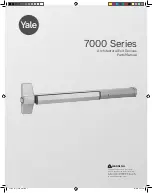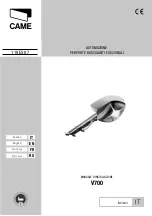
.
A complete Parts List is available at www.MillerWelds.com
OM-242 880 Page 44
7-7. Troubleshooting Power Source
Trouble
Remedy
No pilot arc; difficulty in establishing an
arc.
Clean or replace worn consumables as necessary (see Section 7-3).
Check for damaged torch or torch cable.
Check position of cut/gouge switch. If using cutting consumables, be sure that switch is in the CUT
position. If using gouging consumables, be sure that switch is in the GOUGE position.
Check retaining cup. DO NOT overtighten cup, hand-tighten only.
No cutting output; Power light off; status
lights off; fan motor FM does not run.
Place Power switch in On position.
Place line disconnect device in On position (see Section 4-13 or 4-14).
Check line fuse(s) and replace if needed or reset circuit breakers (see Section 4-13 or 4-14).
Pilot arc working; no cutting output;
Power light on; status lights off; fan
motor running.
Be sure work clamp is connected to a clean, rust-free workpiece.
Clean or replace worn consumables as necessary (see Section 7-3).
No gas/air flow; Power light on; status
lights off; fan motor running.
Have Factory Authorized Service Agent check for proper torch connections. Check operation of gas
valve AS1, and check gas/air system for leaks. Check filter element (see Section 7-5).
Pressure status light On.
Check for sufficient gas/air supply pressure (see Section 4-6).
Check for dirty air filter and replace, if necessary (see Section 7-5).
Check air lines for leaks.
Have Factory Authorized Service Agent check pressure switch and control board.
Cup status light On.
Check torch shield cup (see Section 7-2). Reset power switch.
If trouble persists, have Factory Authorized Service Agent check torch and unit.
Temperature status light
On.
Unit overheating (see Section 4-3). Allow fan to run; the Trouble light goes out when the unit has cooled.
If trouble persists, have Factory Authorized Service Agent check unit.
Temperature status light On indefinitely. Power source temperature sensors may have failed or ambient temperature is below
−
22
°
F (
−
30
°
C).
Operate unit in a warmer ambient temperature.
Temperature status light flashing rate
steady (indefinitely).
Power source temperature sensor(s) provided inaccurate feedback, but have returned to normal. Unit
power must be cycled off and back on again.
Power light flashing steady for 15 sec-
onds or until torch trigger is pressed,
whichever happens first.
Input power was above 300 volts AC or below 156 volts AC, but has returned to normal. Have a qualified
technician check input line power at idle and while cutting.
Power light is flashes at a rate of two
quick cycles and then a one second
pause.
Input power is above 300 volts AC or below 156 volts AC. Have a qualified technician check input power
at idle and while cutting.
Pre-charge PTCs are overheated. Allow 15 minutes for unit to cool.
Pressure status light flashes at a rate of
two quick flashes and then a one second
pause for a duration of 15 seconds.
Unit regulated pressure is too high. Check for input pressure between 90-120 PSI (see Section 4-6). If
trouble persists, have a Factory Authorized Service Agent check unit. Reset power switch.
Pressure status light flashes steady for
15 seconds or until torch trigger is
pressed, whichever happens first.
Regulated pressure is too low. Check torch for leaks. Check for input pressure between 90-120 PSI dur-
ing cutting (see Section 4-6).
Summary of Contents for CE-60T
Page 51: ...OM 242 880 Page 47 Notes ...
Page 52: ...OM 242 880 Page 48 SECTION 8 ELECTRICAL DIAGRAM Figure 8 1 Circuit Diagram ...
Page 53: ...OM 242 880 Page 49 243 018 C ...
Page 57: ...Notes ...
Page 58: ...Notes ...













































